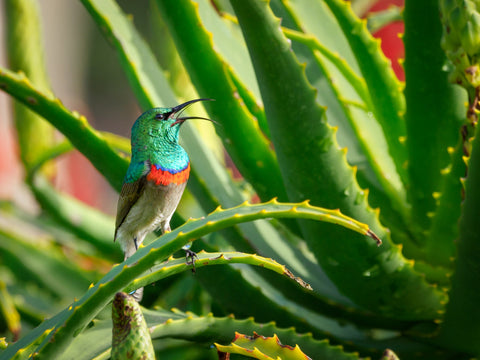The Science Behind Hummingbird Hovering: How Do They Stay So Still?
In this blog post you'll learn all about how the hummingbird hovers and much more.
Hummingbirds are a marvel of nature, captivating us with their vibrant colors, rapid wing beats, and seemingly magical ability to hover in mid-air. These tiny avian wonders are not only a joy to observe but also a subject of scientific intrigue.

The secret to their extraordinary hovering lies in a combination of unique physiological adaptations and aerodynamic principles that allow them to stay remarkably still, defying gravity and even inspiring human technology. Let's delve into the science behind hummingbird hovering and uncover the fascinating mechanisms that make it possible.
This is one of our best selling copper hummingbird feeders.
Aerodynamic Mastery: The Basics of Hovering
To understand how hummingbirds hover, it's essential to grasp the fundamentals of aerodynamics that come into play. Hovering involves maintaining a stable position in the air by generating enough lift to counteract the force of gravity. This requires an equilibrium between the downward gravitational force and the upward lift force created by the bird's wing movements.
1. Rapid Wing Beats
One of the key factors that enable hummingbirds to hover is their rapid wing beats. Hummingbirds flap their wings at an astonishing rate, ranging from about 50 to 80 times per second, depending on the species. This rapid motion creates a consistent flow of air over the wings, generating lift and allowing them to maintain their position in mid-air.
2. Figure-Eight Wing Path
Unlike many birds that move their wings primarily up and down, hummingbirds perform a figure-eight motion with their wings. This figure-eight pattern enables a continuous generation of lift throughout both the upstroke and downstroke of each wing beat. As a result, hummingbirds can sustain hovering for extended periods without succumbing to fatigue.
3. Muscle Power and Precision
Hovering is an energy-intensive activity that demands substantial muscle power. Hummingbirds possess specialized muscles that are capable of rapid contractions, enabling them to achieve the high wing beat frequencies required for hovering. These muscles are densely packed, making up a significant portion of the bird's body mass and enabling them to generate the necessary force for sustained flight.
4. Complex Wing Morphology
Hummingbirds have evolved unique wing morphology that contributes to their hovering prowess. Their wings are relatively long and narrow, allowing for increased surface area and generating more lift. The arrangement of wing feathers also plays a crucial role in creating the necessary aerodynamic forces for hovering.
Staying Stable: The Role of Air Vortices
Maintaining stability while hovering is a delicate balance. To achieve this, hummingbirds utilize a phenomenon called "wake capture." As the hummingbird moves its wings forward and backward in a figure-eight pattern, it creates small vortices of air at the tips of its wings. These vortices act as a source of lift during the subsequent wing beat, helping the bird remain stable and providing the necessary control to adjust its position.
Here's a wonderful unique blown glass hummingbird feeder that is truly a work of art.

Energy Efficiency: A Remarkable Feat
Hovering requires a significant amount of energy, making it an impressive feat that has intrigued researchers for years. To conserve energy, hummingbirds have evolved unique mechanisms. They are capable of entering a state of torpor—a temporary reduction in metabolic rate—during periods of rest, allowing them to save energy and replenish their resources for the next round of high-energy activities, such as feeding or hovering.
Bring your love of hummingbirds inside with this beautiful hummingbird canvas wall art.
Inspiring Human Technology
The science behind hummingbird hovering has even inspired human engineers and researchers. The incredible agility and stability exhibited by hummingbirds have led to the development of robotic drones that mimic their wing movements and hovering capabilities. These bio-inspired drones have potential applications in fields such as surveillance, environmental monitoring, and search and rescue missions.
Intricacies of Perception: Visual Tracking
To truly appreciate the complexity of hummingbird hovering, consider the challenge of visual perception. As they move with such remarkable speed and agility, observing the details of their wing movements can be challenging for the human eye. High-speed cameras and advanced imaging techniques have enabled scientists to capture and analyze the intricacies of their flight in slow motion, revealing the precise mechanics of their hovering.
Looking to take your love of hummingbirds with you all the time? How about this hummingbird t-shirt.
A Natural Wonder
In the realm of avian wonders, the hummingbird's ability to hover stands out as a captivating display of nature's ingenuity. Through a combination of rapid wing beats, figure-eight wing patterns, muscle power, and intricate aerodynamics, these tiny birds achieve the seemingly impossible feat of staying still in mid-air. Their remarkable abilities continue to inspire scientific research, technological innovation, and a sense of wonder that reminds us of the intricate beauty of the natural world.

Appreciating the Extraordinary
As you watch a hummingbird hover, take a moment to reflect on the intricate dance of forces and adaptations that enable this breathtaking display. The science behind hummingbird hovering offers a glimpse into the complexities of nature's design, reminding us of the wonders that unfold all around us. These miniature aviators, with their ethereal beauty and remarkable capabilities, serve as a reminder of the boundless curiosity and exploration that the natural world has to offer.









